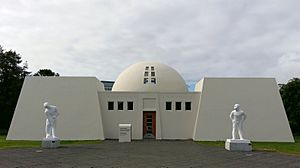Ásmundur Sveinsson facts for kids
Quick facts for kids
Ásmundur Sveinsson
|
|
|---|---|
| Born |
Ásmundur Sveinsson
20 May 1893 Kolsstadir, Iceland
|
| Died | 9 December 1982 (aged 89) |
| Nationality | Icelandic |
| Known for | Sculpting |
| Spouse(s) | Gunnfríður Jónsdóttir |
Ásmundur Sveinsson (born May 20, 1893 – died December 9, 1982) was a famous Icelandic sculptor. He created many unique artworks, often inspired by Icelandic stories and people. His sculptures can be seen in public places and at his former home, which is now a museum.
Becoming a Sculptor
Ásmundur Sveinsson was born in a place called Kolsstadir in West Iceland in 1893. When he was 22, in 1915, he moved to Reykjavík. There, he started learning about art at the Technical College of Iceland. He also worked with a sculptor named Ríkarður Jónsson for four years.
In 1919, Ásmundur traveled to Copenhagen, Denmark, and then to Stockholm, Sweden. He studied at the Academy of Fine Arts in Stockholm for six years. During this time, he learned a lot from a well-known sculptor named Carl Milles.
After finishing his studies, Ásmundur moved to Paris, France. He continued to learn and improve his sculpting skills there. In 1924, he married another sculptor, Gunnfríður Jónsdóttir. They later divorced.
His Amazing Artworks
Ásmundur came back to Iceland in 1929. He started making sculptures that showed people in a new, more abstract way. Many of his early works were about everyday people doing their jobs. Some examples include The Blacksmith, The Washer Women, and The Water Carrier. These sculptures showed the strength and hard work of ordinary people.
As time went on, in the 1940s and 1950s, Ásmundur's art became even more abstract. This means his sculptures looked less like real people or animals and more like shapes and forms.
Like many artists from Iceland, Ásmundur often found ideas for his art in his country's old stories and traditions. For example, he made a sculpture called Trollwoman (1948). He also created Head Ransom (1948), which was inspired by a poem written by the famous Viking Egil Skallagrimsson. Another piece, bleep-Ride (1944), came from the ancient Icelandic book called the Prose Edda by Snorri Sturlusson.
You can find his sculpture Sæmundur and the Seal in front of the main building of the University of Iceland in Reykjavík. Ásmundur believed that art should be for everyone, not just a few people. That's why many of his sculptures are placed in public areas.
Other works by Ásmundur Sveinsson can be seen on a hill called Öskjuhlíð near Perlan in Reykjavík. You can also find his art at a farm called Borg á Mýrum near Borgarnes. There, an abstract sculpture shows the saga hero Egill holding his dead son. This sculpture is called Sonartorrek, named after a sad poem Egill Skallagrimsson wrote about losing his son.
Ásmundur Sveinsson passed away in Reykjavík in 1982. In 2015, one of his statues, which shows the poet Einar Benediktsson, was moved to a spot near the Höfði house in Reykjavík. This is where the poet used to live.
Ásmundarsafn: His Museum Home
Ásmundur Sveinsson's old house in Laugardalur, Reykjavík, is now a museum called Ásmundarsafn. He designed the house himself in the 1930s. He was a big fan of the Bauhaus style, which was a modern way of designing buildings and art. The house even reminds some people of the famous architect Le Corbusier's work.
Outside the museum, there is a sculpture garden. This garden is open to everyone, so you can walk around and enjoy Ásmundur's amazing sculptures outdoors.
See also
 In Spanish: Ásmundur Sveinsson para niños
In Spanish: Ásmundur Sveinsson para niños



